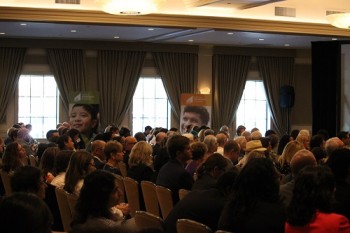Afterschool programs teach students tech as LAUSD restructures
When Jonathan Marcelino’s parents told him he could either own a computer or a cell phone, the decision was not difficult for the 17-year-old to make.
As the eldest of four children born to Mexican immigrants living on a tight budget in Nickerson Gardens, a Watts public housing project, Marcelino knew that although he would have liked to have a phone to regularly text friends, a computer would be more productive.
“Regardless of where I go, I want to study computer science,” he said. “I want to do cool stuff, make money and then do a nonprofit. That’s why you don’t see me running with a phone.”
The lack of exposure to technology and its practical applications in daily life is a reality many students living in and around South Los Angeles face, Marcelino said.
Help L.A. students name the Crenshaw/LAX tunnel boring machine
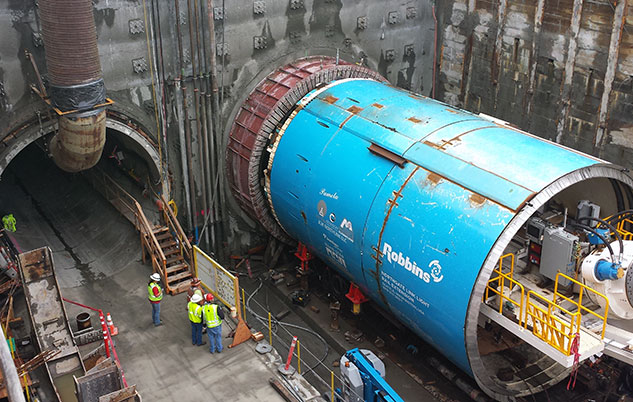
The Crenshaw/LAX line’s twin tunnels will be carved out by a soon-to-be-named tunnel boring machine (TBM) similar to Pamela (pictured in blue), which was used to carve out the Northgate Link Extension in Seattle, WA. | Sound Transit, Flickr Creative Commons.
In keeping with a 700-year-old mining tradition, Metro plans to give a female name to the tunnel boring machine (TBM) that will excavate the twin tunnels for the Crenshaw/LAX line.
But it needs the public’s help.
Metro is requesting public participation in voting to select the LAUSD student-submitted name and artwork to be featured on the machine during an early 2016 lowering ceremony.
Although the TBM has “boring” spelled out in its moniker, the process of keeping with mining history has been anything but. Rather, it’s been a creative process.
LAUSD students in sixth to 12th grades submitted their choice of either a 200-word essay or two-minute video outlining why a suggested name would best suit the 950-pound, 400-foot-long machine.
Additionally, students in kindergarten through fifth grade entered artwork to be featured alongside the winning name.
Representatives from Metro, the office of L.A. County Supervisor and Metro Board Chair Mark Ridley-Thomas, Walsh/Shea Corridor Constructors and staff, and the Crenshaw Community Leadership Council selected the finalists from a pool over more than 200 entries submitted since June.
The top 10 name finalists are Lorena (Lorena Weaver), Sojourner (Sojourner Truth), Maya (Maya Angelou), Eleanor (Eleanor Roosevelt), Harriet (Harriet Tubman), M.A.C. (Make A Change), Sally (Sally Ride), The Africana, Rosa (Rosa Parks), and Athena.
Three student contest winners from each category will be awarded with a $100, $200 or $300 TAP card during the lowering ceremony. Voting for the favorite name and artwork is open now through Dec. 1.
Digging 60 feet per day, it will take a year for the TBM to excavate the 1-mile twin tunnels beginning at the northeast corner of Crenshaw Boulevard and Rodeo Road and will connect the Crenshaw/Expo, Martin Luther King Jr. and Leimert Park underground stations.
The tunnel boring is a part of the construction of the more than $2 billion Crenshaw/LAX light-rail project that will connect the Green and Expo lines. The new route will consist of eight new stations to serve the Crenshaw, Inglewood and LAX communities. It is expected to open in 2019.
South LA youth, non-profits sue city over neighborhood oil drilling
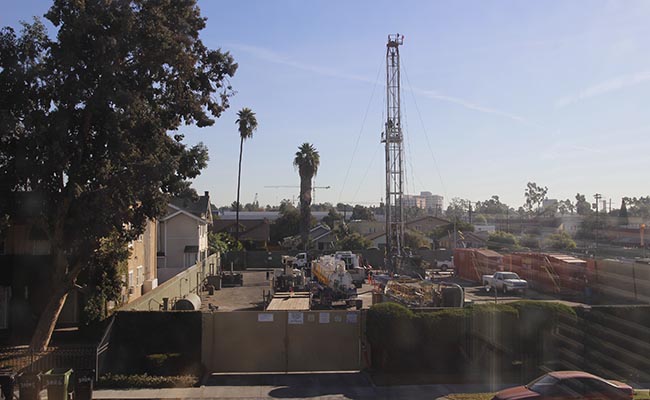
At its closest point, the Jefferson drill site is only three feet from homes. | Caitlyn Hynes, Intersections South L.A.
A few blocks west of the University of Southern California, behind ivy-covered walls, is the Jefferson oil-drilling site. The walls may block neighbors from seeing what goes on behind them, but they know, nonetheless.
Now, South Los Angeles youth, tired of living near toxic chemicals with little protection, are joining together with environmental non-profits to sue the city.
The Jefferson drilling site, owned and operated by Freeport-McMoran Inc., is one of the sites named in a lawsuit brought against the city. Located in the heart of a South Los Angeles neighborhood, the site is protected only by a retaining wall that neighbors say does little to contain the noise and odors produced by drilling. Other South L.A. sites face similar problems.
The plaintiffs in the lawsuit, the South Central Youth Leadership Coalition, Communities for a Better Environment, and the Center for Biological Diversity, held a press conference last Friday to announce the case. The groups allege that the city has not only violated regulations from the California Environmental Quality Act by issuing exemptions for environmental impact reports on oil drilling and production sites, but that it has also forced residents of color to bear disproportionate environmental and health burdens because of the lack of safety measures around several South Los Angeles sites.
Standing outside City Hall Friday with signs with that read, “Our health is not for sale” and, “Ain’t no power like the power of youth,” the minors stood behind speakers who demanded that the city comply with the California Environmental Quality Act by conducting environmental impact reports and providing better protection from, odors, toxins and noise pollution at the drilling sites.
“Our health and our environment are at risk. Community members should not have to jeopardize their health by simply being at home,” high school student Joshua Navarro told the press.
The lawsuit comes on the heels of an October audit that found that since 2007, most Los Angeles oil sites have not been subjected to an environmental impact report assessing the site’s health and environmental impacts on surrounding communities.
Reports from Al-Jazeera America found that the Jefferson drilling location is one of the sites lacking such documentation. It is currently unclear why these oversights have continued.
Protests and this lawsuit against oil companies have drawn the support of youth who live in the neighborhoods surrounding the Jefferson drill site. Many of the kids involved have lived around the site for years. They’ve smelled the chemicals and heard the loud sounds that often accompany drilling.
Elena Hume, 10, has been involved with several protests. She said she and her family would smell the chemicals as they went on walks around their neighborhood.
“I never knew it was an oil-drilling site. We’d see the bushes, and the rows of trees, and the big yellow gate,” Hume said. But now she knows what is happening and she feels it’s wrong to expose her neighborhood to the fumes of the toxic chemicals.
Jordan Parks, 12, has lived near the site his entire life. For a long time he and his family didn’t know exactly what was behind the walls. But when his father discovered it was an oil-drilling site, “Everyone started realizing how incredibly bad it was,” Jordan said.
Youth from the neighborhood around the Jefferson site, brought together by school, church and neighborhood tutoring programs, have become more involved in the issue through protests at the drilling site over the past few years.
Richard Parks, Jordan’s father, said that the kids were the ones who wanted to take action. He said the youth wanted to initiate the process because their homes and families were being directly affected.
A report from the National Resources Defense Council found that the chemicals used at oil drilling sites have been linked to cancer and other reproductive health problems. Neighbors have also blamed the site for headaches, nosebleeds and asthma.
Tanja Srebotnjak, a professor at Harvey Mudd College who has worked in oil and gas research for over fifteen years, said that the closer neighbors are to the chemicals used at oil drilling sites, the more susceptible they are to health complications.
“Farther is better and some states and municipalities have set distances ranging…up to 1,500 feet, 2,000 feet,” Srebotnjak said.
But a 2014 Community Health Councils study found that South L.A. drilling sites located in neighborhoods with high percentages of people of color were significantly closer to homes, schools and churches than sites in West L.A.
While the average distance from homes, schools and churches in South L.A. is 85 feet, the West L.A. and Wilshire sites, located in primarily white neighborhoods, are about 400 feet away.
Many West L.A. sites also have enclosed structures or some type of geographic barrier like a golf course that can help mitigate noise and odors. The Jefferson site, in contrast, has only a retaining wall as physical protection.
Niki Wong of Redeemer Community Partnership, a South L.A. non-profit that works in the neighborhood around the Jefferson drill site, estimated that the wells at the site are a mere 60 feet from homes, a distance that almost certainly exposes residents to toxins. Without an environmental impact report, it is hard to know exactly how the community would be affected if an explosion or other accident were to happen on the site.
Wong said that it is key to involve the youth of the neighborhood in this effort. “It’s important for them [to recognize] the need for a healthy and safe environment to grow up in.”
As for the kids around the Jefferson drill site, they say they just want their neighborhood to be safe for families. “It’d be nice if they just shut [the drilling site] down and turned it into a park or something, or more housing,” said Jordan.
The city attorney’s office told the Los Angeles Times that it will review the lawsuit.
Local leaders stress unity in fighting Reef development
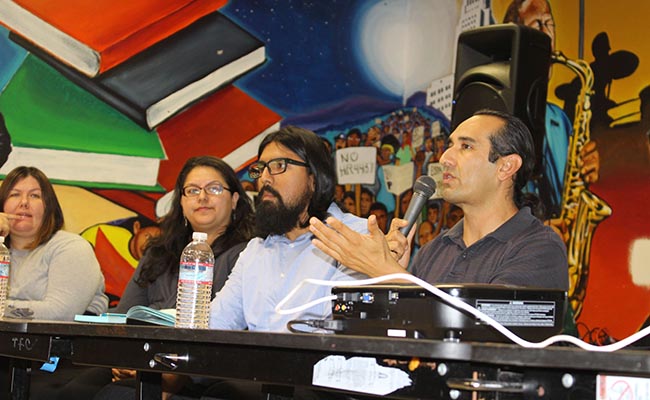
Panelist Jorge Rivera discussed methods to combat gentrification in South Los Angeles based on his experience in Long Beach. | Matt Lemas, Intersections South L.A.
Local advocates against citywide gentrification gathered Oct. 28 for a discussion on methods to combat a $1 billion multi-use development in South Central Los Angeles.
The Reef development, a planned residential, hotel and retail complex to be built in two parking lots just south of Washington Boulevard on either side of Broadway, has many in the community riled up. The proposed luxury site ignites residents’ fears that the development will drastically alter the community make up and increase nearby rents, displacing thousands that have lived in South Central for generations.
“We’re not anti-development,” said Jorge Rivera, a community organizer for Housing Long Beach, an organization focused on improving affordable housing in the city. “We want development, but we want to be able to stay and enjoy that development.”
Hosted by the South Central Neighborhood Council, Wednesday’s panel discussion brought in advocates from Atwater Village, Downtown, Boyle Heights and Long Beach. All groups discussed their own experiences fighting gentrification in their respective locales. The discussion both demonstrated support for the South L.A. community and provided tips for the fight against the Reef development.
About 80 people attended the forum held at the Santee Education Complex. The meeting’s theme centered around concerns that communities have been ignored by private and public investment for decades, leading to their decline. Now, in addition, residents have witnessed a surge in outside development that doesn’t cater to the community make up.
“This community was created by discriminatory practices,” Rivera said. “Government and businesses didn’t invest here…but now they want to ‘improve’ or ‘better’ the community. They’re investing for their own purposes; they don’t take into account the community.”
Panelists stressed that in the fight against private development, those against the Reef should encourage “people power” over money as organizations’ main tool in pushing back.
“Focus on human capital,” said panelist Michelle O’ Grady, member of the Atwater Village Neighborhood Council.
The room seemed to be split on whether or not local residents could trust Councilman Curren Price, who oversees District 9 where the Reef’s project site is located, to speak out against the development.
Price has not taken an official stance on the complex. In the past he has said the Reef could serve as a “lower-cost” alternative to downtown, and on Monday, in light of local complaints on the development’s luxury nature, he told ABC7 the development will be supplemented by two upcoming affordable housing projects “minutes” away from the Reef.
The two additional housing complexes, Price said, would supply hundreds of construction jobs. Current plans for the Reef allot none of its spaces to affordable housing.
Community members cited that construction jobs are only temporary, however, and interpreted Price’s neutrality and comments as damaging and indicative of a pro-developer’s stance.
“Price has not taken a position which it in itself is a decision,” Rivera said, citing that his comments lean more toward approving of the Reef.
“His lack of decision could lead to more homelessness in this city,” added panelist Jose Fernandez, alluding to the potential effects of a displaced community.
In the fight against the Reef, a recent point of contention among residents has been the Nov. 2 deadline for submitting public comment against the development. The South Central Neighborhood Council stressed it has not had not had enough time to review the 3,000 page environmental impact report released in September.
The public comment period has still not been extended. Price has said on record that extensions are only allowed if new information has come forth, which has not been the case.
A Reef representative told Intersections last week that after the public comment period, the company will still be open to hearing local input regarding a community benefits package attached to the project, which among other things, could stipulate how the development’s future tenants hire for their spaces.
Job growth is a common argument for those who favor gentrification, but the panelists warned that the jobs aren’t always given to those in the surrounding community.
“There’s no guarantee the tenets will do local hiring,” said panelist Roxana Alguilar, who worked in job placement during the construction of L.A. Live.
During the event’s Q&A period, there was a virtual agreement among the crowd that, rather than combatting the issue of gentrification on a project-by-project basis, organizations would have to form a unified coalition to fight displacement from both the Reef and in the city at large.
Accompanying that call was one to disregard racial differences and combat developer money with unified human capital.
“If we come together as black and brown…it’s a lot of people power,” said Crystal Mitchell, co-director of the nonprofit business and community development organization Recycling Black Dollars. “They’re expecting apathy.”
South Central development project concerns neighbors
A new South Los Angeles development project drew sharp criticism from neighbors and health advocacy groups at a press conference Monday. A report released by Human Impact Partners found that “The Reef” development, slated to build two multi-use high-rise buildings, will place over half of renters in the site’s surrounding area at high risk for financial strain or displacement.
In September, the City Council released a 3,000 page environmental report on the development. The document has been has been a source of strain on attempting to be involved in the development process.
“In the immediate, we are concerned about the draft [environmental impact review] project that has only given us 47 days to respond to a 3,000 page document,” said Benjamin Torres of CDTech.
Beyond the environmental impact report, the community is concerned that the development will bring new residents into the proposed luxury apartments while pushing out lower-income locals because of rising rent and property value.
Read More: Neighborhood council to take action on Reef Project report
Los Angeles is the least affordable city for renters, and HIP found that the city lost 65 percent of state and federal funding for affordable housing between 2009 and 2014.
The South Los Angeles neighborhood surrounding the development is one of the most crowded areas in the city. In the community where 45 percent of residents fall below the poverty line, a rise in prices leaves many residents forced to compromise.

Residents hold a press conference in front of The Reef, which plans to develop two new skyscrapers in South LA over the next 15 years. | Caitlyn Hynes, Intersections South L.A.
Community members are worried that The Reef development will not include affordable housing, an issue that already exists. At the press conference, residents and community leaders urged developers and the City Council to consider their voices throughout the 15-year building process.
Benjamin Torres of CDTech said he was concerned that the decisions made about the development would not include the input of the neighbors who currently live there.
“One [concern] is the long-term process and what the role of the community is, and making sure we have equitable community development that benefits the area,” he said.
Neighbors want South L.A. to attract developers. They also want development to reflect the neighborhood’s residents as they are now, not those who will move in to be a part of The Reef’s demographic.
“Let’s imagine for one minute what this project could be. Imagine if this was affordable housing for the residents of affordable housing for South Los Angeles,” said Jim Mangia, President and CEO of St. John’s Well Child and Family Center. “Imagine if that development was serving the people of this community, who have built this community with their blood and their sweat and their tears. Imagine if some of that retail space were community health centers that served this community.”
Read More: Some South LA residents express uncertainty with billion dollar development
Dr. Holly Avey of HIP said that her organization was concerned about the negative impact that this development could have on the historic South Central L.A. neighborhood. The report found that community residents who are impacted by displacement and financial issues are at a high risk of a variety of health problems, including anxiety, depression, obesity and diabetes.
Beatriz Solis of the California Endowment said that some families are forced to make delicate tradeoffs, like choosing between healthy food or preschool.
Cynthia Bryant, the owner of a local ice cream shop, voiced her concern that when the development does go forward, the businesses in The Reef will push her out of the neighborhood. Bryant worries that the business space in The Reef will drive up rent prices across the neighborhood.
“I don’t want to be the first one to get on the boat if we get pushed out of this community, because they’re pushing us further and further. But where is the boat loading? Should I be the first or should I be the last, should I keep hanging on?” said Bryant.
The rising rents and subsequent displacement of residents worries Solis as well.
“At the community level, when people are forced out, the whole community fabric begins to unravel, and what cohesion and collaborative efficacy, or social and political power did exist begins to evaporate, making it more and more difficult to have a voice in community development,” Solis said.
Neighbors like Erendira Morales, a working mother of four children, say they want to be a part of this process to make sure that their concerns are being heard and addressed.
“We feel that they are playing with the life and the future of the people who live in this community. Our local representatives are not listening to us,” said Morales. “We have our interests, we have our opinions and we feel that they are not paying attention to us. We want to participate, we want to be part of this process.”
Call for ‘Black Lives Matter’ to Apologize
Pastors and community leaders came together at Mount Moriah Baptist Church to call for an apology from the Black Lives Matter movement. The actions of members of the local chapter upset leaders last week after a meeting with Mayor Eric Garcetti took an ugly turn.
“We say today to Black Lives Matter Los Angeles, do the right thing,” Rev. Xavier E. Thompson said. “We are not against you. But certainly, you have offended not only a house of worship but you have offended the entire faith based communtiy.”
At Monday night’s forum, protesters turned their backs to the mayor as he spoke, and then surrounded his car as he tried to leave.
The mayor released a statement the next day saying “[I] will continue to be there to hear those concerns and find solutions to our most pressing problems. We must move forward and I remain committed to our shared concerns.”
Rev. Kelvin Sauls, the pastor of Holman United Methodist Church, revealed that he was threatened by members of the Black Lives Matter movement that night.
“I was there,” Najee Ali said. “I saw with my own eyes Pastor Sauls be physically threatened with violence in his own church. That’s unacceptable for Black Lives Matter activists to threaten anyone with violence.”
Although many people think this could cause division within the Black Lives Matter movement, Rev. Paulette Gipson, the president of Compton NAACP, believes they are together though their methods are different.
Content originally posted by Annenberg TV News.
Neighborhood council to take action on Reef Project report
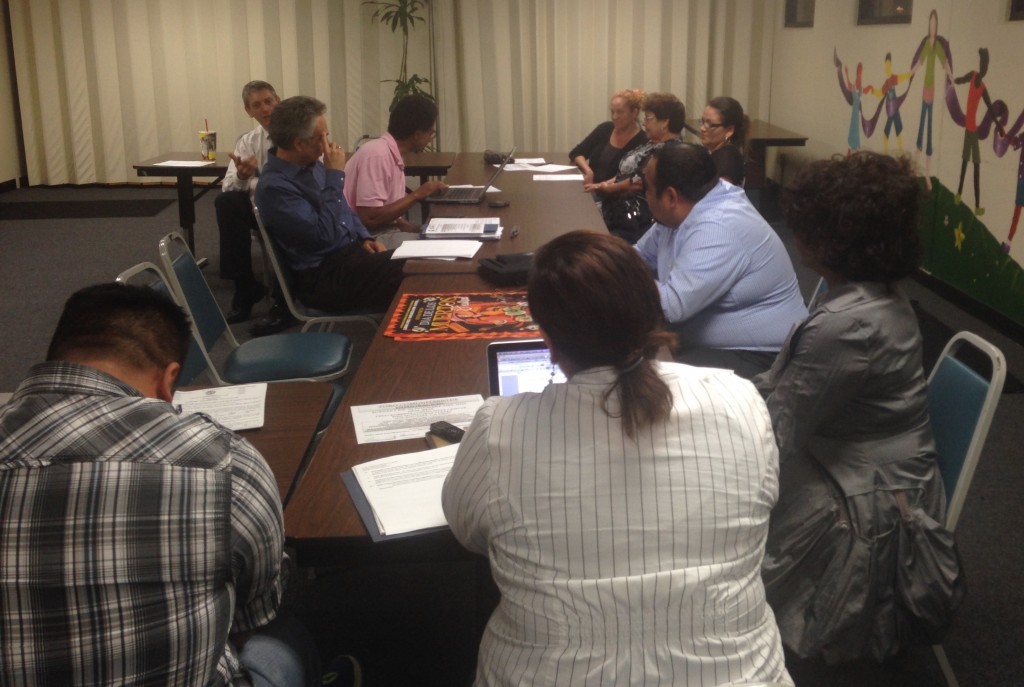
The South Central Neighborhood Council and community members discussed possible courses of action on the Reef Project Environmental Impact Report on Tuesday, October 20, 2015. | Rachel Cohrs, Intersections South L.A.
With the deadline for public comment on more than 800 pages of documentation on the proposed Reef Project development approaching, the South Central Neighborhood Council said it needs more time to sort through the information.
“The language is hard to understand, and it’s just too much,” said council member Martha Sanchez. “I want to be able to understand what I’m reading. . .I want to have time for an expert who knows more to explain what this means to community members.”
The Reef Project is a $1.2 billion development of high-rise condos, commercial space, and a hotel to be erected in South LA. The project has received some pushback from community residents.
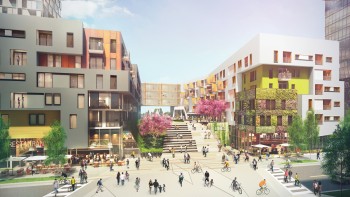
A rendering of the proposed $1.2 billion Reef Project development. | Courtesy of Gensler and PATTERNS
The paperwork under review is the Environmental Impact Report that describes the different community impacts the project could have on nearby residents. The Los Angeles Department of City Planning’s summary of the report describes that the Reef Project’s largest disruptions will affect local aesthetics, air quality, noise, traffic and transportation.
The report, released Sept. 17, is available solely in English, and is only available by either visiting the Department of City Planning office, visiting one of four library locations, or paying $7.50 for a copy on CD.
“Looking at this neighborhood, for [the document] only to be provided in English is absurd. We have lots of monolinguistic Spanish-speaking people around here. It’s hard enough for the average person to understand, not to mention if they don’t speak the language,” council member John Parker said.
The South Central Neighborhood Council has authorized a committee to submit a public comment before the Nov. 2 deadline. The statement will be based on community input the council has gathered since its town hall meeting last month. The exact content has yet to be determined.
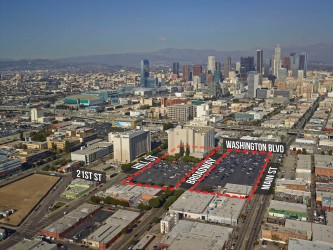
A visual map of the location of the Reef Project south of downtown Los Angeles. | Courtesy of Gensler and PATTERNS
The council also plans to submit a request to the city to extend the deadline, but the prospects of success look grim after another organization’s request was denied.
Reef Project representative Will Cipes said that although the official deadline for comment may pass on the report, the developers will still be open to community insight regarding a community benefits package attached to the project.
According to Cipes, however, the community benefits package with the city isn’t quite concrete.
“We have talked about the broad concept of an agreement [on a benefits package] but we have not talked specifics,” Cipes said.
Cipes estimated that the official city council vote on the development will likely be at least six months away.
The Environmental Impact Report didn’t measure how much potential displacement the existence of market-rate apartments could cause in the surrounding area. Preliminary analysis conducted by SAJE, a local nonprofit advocating for tenant rights and affordable housing, identified 4,445 individuals within a two-mile radius of the Reef Project who could be at “very high” or “high” risk for financial strain and/or displacement if the development is built.
To educate community members and provide a place for residents to voice concerns about the project, the South Central Neighborhood Council is organizing a community forum on gentrification Wednesday, Oct. 28 at Santee Education Complex at 6 p.m.
“We want to do something that is really going to benefit people,” South Central Neighborhood Council President Jose Reyes said. “We don’t want to do something just to say we did something.”
South L.A. Structures on Shaky Foundations
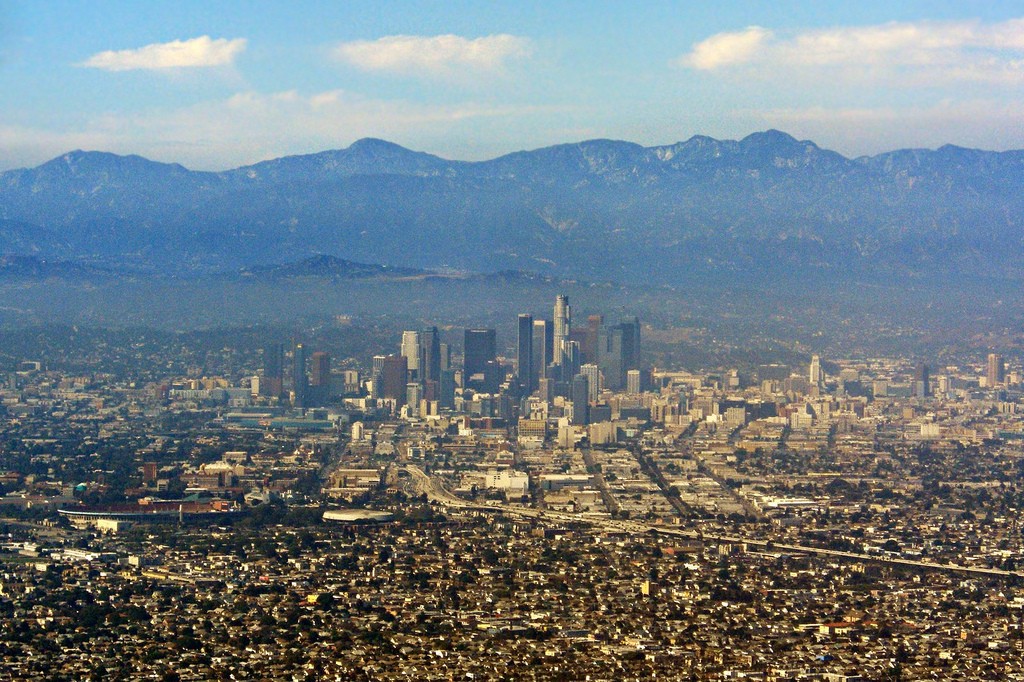
Experts say thousands of Los Angeles homes will collapse in a large earthquake.| Cameron23, Flickr Creative Commons
Imagine the Los Angeles skyline in its entirety. Include the apartment and commercial buildings; the houses old and new. Now, imagine 50 percent of those buildings gone—collapsed either partially or completely.
That is the bleak picture that U.S. Geological Survey seismologist Dr. Lucy Jones painted for attendees during the 2015 Great California ShakeOut Breakfast Leadership Summit on Sept. 30.
Los Angeles has not experienced a major earthquake in 20 years. The last large temblor to slam the region was the 1994 Northridge earthquake. Since then, California faults have been in a quiet period that Jones and other experts on her team insist won’t last.
The period of smooth sailing has caused home and commercial building owners to relax their approach to protecting structures against the damage they could sustain in the violent shaking during a substantial quake.
Lack of action to strengthen structures, however, renders the millions of people who live and work in the city’s 300,000 unstable buildings susceptible to displacement from work or homes, and even disaster-related death.
Non-profits get billion dollar boost
The California Community Foundation pledged $1-billion to Los Angeles County non-profits today during a special town hall meeting at the St. Sophia Cathedral in Mid-City. An estimated 400 civic leaders, including L.A. Mayor Eric Garcetti and County Supervisor Mark Ridley-Thomas were among the attendees.
The town hall meeting and funding announcement was part of a celebration of CCF‘s 100th anniversary.
The money will be disbursed over a ten year period and will be paid out in the form of grants, loans and scholarships. Which non-profits will get funds and how much they will get are unknown.
Jonathan Zeichner, Executive Director of the South L.A.-based A Place to Call Home, said that communication between groups like his and the Foundation is key.
“We’re on the ground representing the constituents that we serve,” he said. “[It’s] really important that it’s a two way dialogue.”
CCF President, Antonia Hernandez said she hopes to focus on low income housing, community clinics, and early childhood education. Groups trying to get a cut of the funds will have their application reviewed by the CCF staff and its 20 member board.
“We’re [non-profits] required to show what we will do with the funds,” said Zeichner. “And if we’re doing we we say we are…that’s the basis to continue the funding.”
Representatives from all of the County’s 88 cities were in attendance, signaling the importance of the funds to public officials who are grappling with increases in crime and homelessness in many of their communities. Their combined attendance was also a sign of unity among the county’s various municipalities.
Since 2013 homelessness has risen by 12% across L.A. County, a fact that many attribute to the area’s tight housing supply. A report from the LA Homeless Services Authority released earlier this year had the number of homeless people in the county at more than 40,000.
The problem has gotten so bad that this past month the L.A. City Council declared a “state of emergency” over the issue and dedicated $100 million towards homeless services like shelters and housing vouchers.
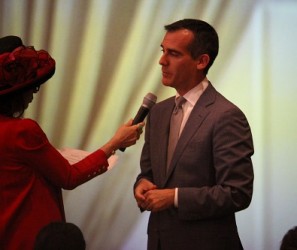
Mayor Eric Garcetti at California Community Foundation Town Hall on October 8, 2015 | Photo by Kevin Walker
Mayor Garcetti, speaking at today’s event, referenced the challenges facing the county but stressed the need for civic pride.
“We’re good at privately saying what we love about L.A., but publicly bitching about what we don’t,” Garcetti said. “We need to invert that.









